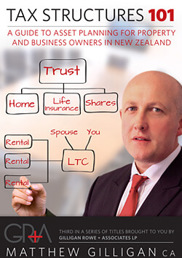
Application is Residential Land Only
The proposed rules will apply to residential land only. This aligns the ring-fencing rules with the bright-line rules, which also apply only to residential land. Broadly speaking, residential land is land that has a dwelling on it or land that is capable of having a dwelling built on it due to zoning classification. Excluded from this is commercial property, a person's main home, mixed used assets (i.e. a bach that is used both privately and to generate income) and residential land that is on revenue account for tax purposes (i.e. land that has been bought as part of a property dealing business, e.g. for development or trading purposes).
Application is not restricted solely to land in New Zealand. Following this, the proposals are intended to apply to rental properties outside of New Zealand that are owned by New Zealand tax residents, e.g. a rental property purchased and owned in Australia by a New Zealand tax resident.
The rules will see tax losses produced by a residential rental property unable to be offset against non-property income. There was a suggestion that perhaps the tax losses should be ring-fenced on a property-by-property basis, meaning that a loss produced by a particular property can only subsequently be offset against taxable income produced by that property, but that is not the current proposal. Instead, the issues paper talks about the ring-fencing applying on a 'portfolio' basis, meaning that profits and losses of different rental properties will be able to be offset against each other. Any surplus loss is then ring-fenced and offset against future property income. Property income includes taxable income on selling a residential property, for example under the bright-line rules. Start Date 1 April 2019
• in full from that date or
• be phased in over a two to three-year period.
This is interesting in that it overrides Labour's pre-election suggestion that any ring-fencing of losses will be phased in over a five-year period, to ensure investors have time to adjust. If the rules are phased in over a two to three-year period, the issues paper suggests that will be accomplished by progressively reducing the proportion of tax losses that can be offset against other income.
There will be avoidance rules to prevent attempts to structure around the rules. The issues paper specifically contemplates a scenario where a taxpayer borrows money to buy shares in a company that owns a property, rather than borrowing money to buy the property itself. The objective in borrowing money to buy shares would be the hope that the loss produced by the interest deductions falls outside the ring-fencing rules. However, the issues paper makes it clear that the loss produced by the interest deductions would be regarded as ring-fenced property losses.
In my view, these rules will weigh a heavy tax toll on lower net worth, lower income families and be quite socially regressive. Consider, who needs tax credits from property losses the most? Poorer, younger, lower net worth investors getting on the property ladder tend to rely on tax credits more. As I have said previously, if interest rates go up substantially due to a disruptive event in financial markets, one could contemplate such lower income/lower equity investors being made insolvent (or more insolvent) by these rules, whereas affluent investors will be less affected. In fact, the poorer investors will be served up as an insolvent dish to the wealthier investors by this policy; it's just a matter of when interest rates spike. It does make me wonder if the Labour Government understands this point – such policy is completely contrary to much of their core voters' interests, while assisting wealthier voters' interests.
Summary
In summary, the rules are intended to prevent the offset of tax losses produced by residential rental property investment against other forms of income. The commentary above is a reflection of proposals only at this stage. This is far from finalised law, but clearly there is an intention to put these rules in place. If you wish to have your say, you can send submissions to [email protected].
If you have any queries regarding loss ring-fencing, please contact us at [email protected] or via GRA's website.

Matthew Gilligan
Managing Director and Property Services Partner
Did you like this article? Subscribe to our newsletter to receive tips, updates and useful information to help you protect your assets and grow your net worth. We're expert accountants providing expert advice to clients in NZ and around the world.
Disclaimer: This article is intended to provide only a summary of the issues associated with the topics covered. It does not purport to be comprehensive nor to provide specific advice. No person should act in reliance on any statement contained within this article without first obtaining specific professional advice. If you require any further information or advice on any matter covered within this article, please contact the author.
Comments
Testimonials
What I enjoyed most about Property School was the great willingness of speakers to let us interact, energy of speakers is massive! Planning strategy going forward, motivation and what mindset/approach is required to do subdivision were the highlights for me. - N N, May 2018
Property 101by Matthew Gilligan
Investing in residential property?
Put this at the top of your reading list.
If you're investing in residential property, seeking to maximise your ability to succeed and minimise risk, then this is a 'must read'.
Matthew Gilligan provides a fresh look at residential property investment from an experienced investor’s viewpoint. Written in easy to understand language and including many case studies, Matthew explains the ins and outs of successful property investment.
- How to find the right property
- How to negotiate successfully
- Renovation do's & don'ts
- Property management
- Case studies and examples
- and much, much more...








































